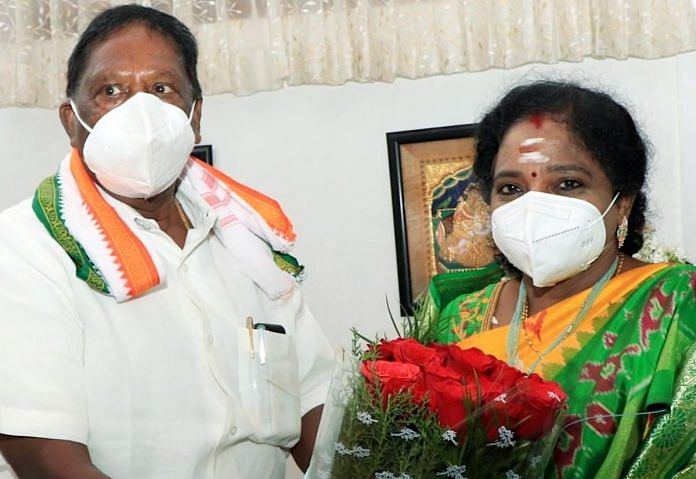New Delhi: Puducherry is in the headlines today because the BJP successfully managed to bring down the Congress-led government there at a time when it does not have a single MLA in that union territory.
“BJP just wants to paint the entire country’s saffron. And if it can’t be saffron, then it should not be the Congress — it should be some party or some faction that the BJP can then dominate,” observed Shekhar Gupta.
In episode 688 of ‘Cut the Clutter’, ThePrint’s Editor-in-Chief Shekhar Gupta looks back and explains the different strategies the BJP has employed to bring down some of the nine state governments, in the span of seven years, including Puducherry and Jammu and Kashmir, and how no prize in politics is too small for the BJP.
Also read: 3 pillars of Modi’s success — infrastructure, welfare, ‘testosterone-driven nationalism’
What happened in Arunachal, Bihar
In November 2015, the Congress had 42 seats in a house of 60 in Arunachal Pradesh. That was when 21 members of Congress Legislature Party (CLP) refused to attend a party meeting, saying that they didn’t have confidence in then chief minister, Nabam Tuki.
J.P. Rajkhowa, who was the governor of the state at the time, advanced the Assembly session that was due in January 2016 to December 2015. However, the courts became involved and that did not happen. Then, on 16 December 2015, 20 rebel MLAs, 11 BJP MLAs, plus two independents and the deputy Speaker, decided to hold an assembly session in a ‘guest house’ outside the assembly premises where they impeached the Speaker and expressed no confidence in the government of the day.
Here too, the courts were involved and while the High Court ruled in favour of the people supported by the BJP, the Supreme Court intervened and restored Nabam Tuki’s government. That was until the Congress Chief Minister Pema Khandu himself along with 31 MLAs joined the BJP, said Gupta.
As we know, Gupta added, the BJP did not win the Bihar assembly elections in 2015 — a combination of Nitish Kumar, Lalu Prasad Yadav’s Rashtriya Janata Dal and the Congress did. But in the course of time, there was trouble between Kumar and RJD over Lalu Yadav’s son Tejashwi Yadav. Soon after, Kumar joined hands with the BJP leaving the Congress and RJD out of the picture. What was an anti-BJP government became an NDA government, explained Gupta.
Also read: What BJP is planning in Puducherry after Congress govt falls as CM resigns before trust vote
BJP does it again in Manipur, Uttarakhand, Karnataka, MP
The BJP then turned to Manipur where, in a 60-member assembly, Congress had 28 seats, just three short of a majority while the BJP had 21. The saffron party’s czar in the Northeast, Himanta Biswa Sharma, presented governor Najma Heptullah with a list of BJP MLAs along with independents. Heptullah then invited them, instead of the single largest party, to form the government.
In Karnataka, the result was very close. BJP had the largest number of MLAs, but they were short by nine of the majority mark. So the two adversaries — Deve Gowda’s Janta Dal Secular and the Congress, which together had 115 MLAs — came together to form the government to keep the BJP out of power. While the saffron party tried its best to step in, the Supreme Court had intervened, cutting these efforts short. However, defections were underway and BJP’s Yediyurappa, eventually, became the chief minister.
In Madhya Pradesh, the Congress had 114 MLAs while the BJP had 109 in an assembly of 230 seats. However, as a few independents began joining them, the Congress inched closer to the majority mark and formed a government. When the lockdown was put in place, the assembly session continued till the Kamal Nath government was brought down owing to defections, Gupta added.
In Uttarakhand, the Congress-led Harish Rawat government was brought down after which he was to face a vote of confidence ordered by the high court. But before the vote of confidence was conducted, the Centre imposed President’s Rule, acting on a report by the Governor. The courts were involved yet again, which restored the government.
The most recent example is the union territory of Puducherry. It has three nominated MLAs controlled by the Centre under The Union Territories Act, Article 239A of the Constitution. Much like the 12 members in Rajya Sabha, these nominated MLAs have voting powers. In an assembly of 30 seats, the Congress was missing the majority mark due to defections and also because three MLAs nominated by the Centre would have voted against the Narayanswamy government. The ruling side, therefore, staged a walkout before the confidence vote, questioning the right of these nominated MLAs to vote. It prompted the Speaker to declare that the confidence vote had been defeated.
Gupta ended by summarising the history of what used to be Pondicherry, over which two colonial powers — the French and British — had fought and used it to comment on his overall analysis: “Why should we be surprised if the BJP goes to such lengths to get control of Puducherry, even when they don’t have a single elected MLA?”
Watch full the full CTC episode here:







Shekhar Gupta @The Print weeps again!!
Liberandus weeping is lovely to see!!!